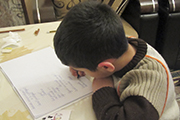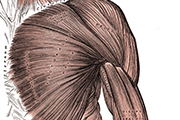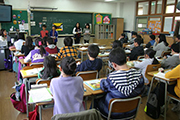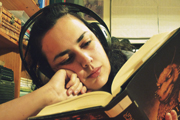18 June 2015
Antiga Fàbrica d'Estrella Damm, Barcelona
Spin UOCs
 RecerTEL
RecerTEL
#RecerTEL
Care services for children with language disabilities
Llorenç Andreu Barrachina, lecturer with the Psychology and Education Sciences Department. Member of the UOC's Cognition and Language Research Group (GRECIL)
RecerTEL is a social project based on knowledge obtained regarding specific language impairment (SLI, or "TEL" in Spanish and Catalan). SLI affects 7% of children and is characterized by difficulties in spoken language acquisition, which is often the cause of academic failure. Despite the high rates of SLI, there is a huge gap between research and the professionals who care for children with this impairment. There is also high demand for advice, training and materials for parents and professionals alike. In this context, RecerTEL has been created to foster actions for the transfer of research in society to generate social progress. To achieve this, the aim of RecerTEL is to become a benchmark centre for language disabilities, specializing in advice and training for parents and professionals and in the production of materials and resources for prevention, improved learning and intervention in specific language impairment.
 Care Respite
Care Respite
#CareRespite
Intelligent care for seniors
Xavier Baró Solé, lecturer with the Computer Science, Multimedia and Telecommunications Department. Member of the Scene Understanding and Artificial Intelligence Lab (SUNAI) research group, attached to the UOC's Internet Interdisciplinary Institute (IN3).
In Catalonia, there are 1,300,000 people over 65, 250,000 of whom have some form of disability. Of these, 28,000 receive no help at all. There are also 80,000 non-professional carers who spend between six and eight hours a day caring for them, and 50,000 who spend between one and five hours. They tend to be the close family of the dependent person, which can be a source of great economic and emotional stress. Care Respite proposes an intelligent monitoring system designed for people who care for a dependent person, especially non-professional carers. This system can detect risk situations day and night and notifies the carer by mobile phone, who can then see what has happened and communicate in real time. The aim of the proposed solution is to improve the carer's quality of life and help them enjoy quality respite. This project is managed by researchers from the UOC, the Universitat Autònoma de Barcelona and the University of Barcelona, together with ACCEPLAN and the Computer Vision Center (CVC).
 VAL-ID
VAL-ID
#ValID
Secure and remote validation of the e-assessment process
Ana Elena Guerrero, lecturer with the Computer Science, Multimedia and Telecommunications Department. Member of the Technology-enhanced Knowledge and Interaction Group (TEKING) research group, attached to the UOC eLearn Center
The aim of the project is to improve the UOC's e-assessment process, both during the continuous assessment activities and in the final assessment tests. The intention is to ensure the authorship and identity of the virtual student, ie recognize that the student is who they say they are and that they are the one who has completed the exercise. To do this, different biometrics techniques will be used, such as facial recognition or keyboard patterns, as well as forensic analysis techniques, to analyse the language used by the student and other educational methodologies and techniques. The target public of the project could be any educational institution that works, fully or partly, in teaching and learning and that wants to improve its assessment system.
 iCity
iCity
#iCity
Circulation with no traffic jams in the cities of the future
Daniel Infante Muñoz, graduate of the Computer Engineering bachelor's degree course
The aim of iCity is to improve city traffic management with measures such as reducing waiting times at traffic lights, favouring the movements of priority vehicles and reducing pollution. Essentially, the proposal consists of establishing a communication system between vehicles and a central data service, and between this service and the traffic lights. The project aims to foster methods and create artificial intelligence systems to allow cities to lighten traffic circulation at specific times of peak traffic flow. The aim of iCity is to build a system to monitor real traffic and that can be adapted to cities and vehicles without causing significant economic impact on town and city councils, state bodies and vehicle manufacturers.
 3D human anatomy atlas
3D human anatomy atlas
#Atlas3D
Inside the human body as you have never seen it before
Santiago Pellicer Pérez, CEO of 3D Visión Médica Virtual, SL
VMV3D is a human anatomy atlas that displays the human body in 3D. This three-dimensional atlas allows you to see the human anatomy through complete systems (bones, muscles, nerves, vessels, organs and senses) or anatomical regions (arms, thorax, pelvis, legs), each with their subsequent layers of systems. All the elements are identified by their nomen (name) and their IAN (international anatomical name). The system loads the complete anatomy once and displays the basis of the selection of the elements. The project managers have developed a user interface that allows functions such as zoom, turn, translation, selection and multi-selection, look-through, hide, search anatomical elements, save images in digital format or search on other platforms using the nomen of an anatomical element. This application has been designed for health professionals and health science teachers and students (Medicine, Physiotherapy, Nursing, Nutrition, Dietetics, Sports Medicine, etc.). Thanks to the information, it can also improve relations between patients and healthcare professionals. The VMV3D platform can currently be used on Mac OS and Windows operating systems and on iOS and Android mobile devices with an app. It will soon be available for large-format touch-screen digital tablets.
 Information literacy
Information literacy
#AucaDigital
Every child is unique, as is every book: personalize children's learning
Asunción Muñoz Fernández, counsellor with the Computer Science, Multimedia and Telecommunications Department, and Pilar Rodríguez González, editorial coordinator of Aucadigital Editores S.L.
The aim of Aucadigital is to create digital educational materials to help improve children's education. These are applications aimed at children who are learning to read and write who have a disability or limited reading skills. The main features of the educational design are based on the creation of graded stories structured over three reading levels, three types of lettering, a text adapted to the international easy-reading guidelines, audio books, reading comprehension activities and monitoring of the child's progress. This product is for parents, nursery and primary school teachers, psychologists and speech therapists who believe in the educational effectiveness of ICT resources and who use them as tools to help with learning. It is also aimed at educational or children's and young adult publishers wishing to digitize their publishing list or create new products, app developers and education companies. This innovation proposal is based on using the creative and technological potential of different mobile devices to create personalized educational materials that present learning as a motivational challenge and experience.
 AudioBox ("My audio book")
AudioBox ("My audio book")
#AudioBox
Create, edit and share your audio books
Pablo Rebaque Rivas and Llorenç Sabaté Jardí, UOC Technology
AudioBox is a web tool currently in operation that allows audio books and audio files to be generated, organized and shared. The tool enables users to browse different sections (such as DAISY books): they can access any section of the audio content and they can stop listening at any time and restart where they left off. AudioBox was designed to help UOC students with functional diversity – both students with long-term disabilities and those with a temporary disability – to carry out reading activities. Students are able to generate an audio book with different audio files, create an internal structure and send it to the tutors when they need to receive a mark. The community can also use the tool to create materials in audio book format.
 Digital acceptance of succession
Digital acceptance of succession
#DelacioDigital
e-Will: last will and testament in the digital world
Paula Rubiralta Pierola, student on the UOC Multimedia bachelor's degree course.
The aim of this project is to propose a solution that establishes last digital wills and testaments offering sufficient legal and technical security guarantees. This situation cannot at present be considered resolved in Spain as often, when a person dies, their family does not know their last digital will and testament, nor do they know the content posted on the Internet regarding this person or of which information they are the owner. The aim of this initiative is to solve the problems derived from digital acceptance of succession through streamlined and efficient mechanisms that offer the user sufficient guarantees regarding their last digital will and testament. These mechanisms must meet these five requirements: legality, agility, privacy, digital nature and internationalization. The companies that currently provide similar services in the market do not meet all these five requirements, which is why they do not work. The success of this project calls for a figure that meets them.


